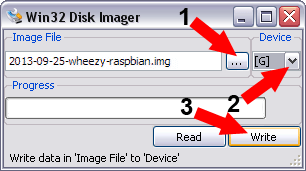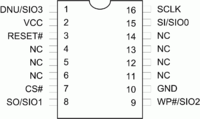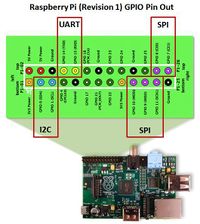JAISPI: Difference between revisions
m (→Installation) |
m (→Installation) |
||
| Line 79: | Line 79: | ||
==== Installing Raspbian ==== | ==== Installing Raspbian ==== | ||
Run win32diskimage | Run win32diskimage (if you use linux you can use dd)<br /> | ||
[[File:Win32DiskImager.png]] | |||
# In "Image file" select the downloaded and decompressed Raspbian image (''2013-09-25-wheezy-raspbian.img'' at the time of this writing) | |||
# In "Device" select the drive where the SD memory is. | |||
# Select "Write". | |||
After finished writing, put the SD card in the Raspberry Pi and power it up by inserting the USB cable. | After finished writing, put the SD card in the Raspberry Pi and power it up by inserting the USB cable. | ||
Revision as of 23:43, 11 December 2013
| This article is marked for rewrite/restructuring in proper wiki format. You can help PS4 Developer wiki by editing it. |
Someone should crosscheck the spanish and realworld into english for wiki here, please.
JAISPI
JAISPI - Raspberry Pi SPI flasher for PS4
Source:
JAISPI - Utility to read and write to the main memory (MX25L25635FMI-10G) of PS4 with the Raspberry Pi through the SPI protocol.
Changelog
- v1.0
- Support MX25L25635FMI-10G
- Reading
- Programming
- Full Erase
Installation Instructions
Materials Required
- 1x Raspberry Pi (see talkpage for where to buy)
- 1x SD Memory (for Raspbian, a 4GB minimal is recommended)
- 1x PS4 Serial Flash MX25L25635FMI-10G desoldered from console
Downloads
- Raspbian (http://downloads.raspberrypi.org/raspbian_latest)
- Win32 Disk Imager (http://sourceforge.net/projects/win32diskimager/files/latest/download)
- Putty (http://the.earth.li/~sgtatham/putty/latest/x86/putty.exe)
Pinout
| 8-Pin | 16-pin | Usage | Raspberry Pi JAISPI |
Description |
|---|---|---|---|---|
| - | 1 | SIO3 | NC | 8pin: Not Available - not used / 16pin: Serial Data Input & Output (for 4xI/O read mode) |
| 8 | 2 | VCC | 17 | +3V DC Power Supply |
| 7 | 3 | HOLD#/RESET# | NC | 8pin: Hold, to pause the device without deselecting the device / 16pin: Hardware Reset Pin Active low |
| - | 4 | NC | NC | No Connection |
| - | 5 | NC | NC | No Connection |
| - | 6 | NC | NC | No Connection |
| 1 | 7 | CS# | 24 | Chip Select |
| 2 | 8 | SO/SIO1 | 21 | Serial Data Output (for 1 x I/O) or Serial Data Input & Output (for 2x I/O or 4x I/O read mode) |
| 3 | 9 | WP#/SIO2 | 25 | Write Protection: connect to GND or Serial Data Input & Output (for 4x I/O read mode) |
| 4 | 10 | GND | 25 | Ground |
| - | 11 | NC | NC | No Connection |
| - | 12 | NC | NC | No Connection |
| - | 13 | NC | NC | No Connection |
| - | 14 | NC | NC | No Connection |
| 5 | 15 | SI/SIO0 | 19 | Serial Data Input (for 1 x I/O) or Serial Data Input & Output (for 2x I/O or 4x I/O read mode) |
| 6 | 16 | SCLK | 23 | Clock Input |
Use short wires, esp. if you are not adding the 0.1µF capacitor between ground and vcc as close as possible to the chip
Installation
Installing Raspbian
Run win32diskimage (if you use linux you can use dd)

- In "Image file" select the downloaded and decompressed Raspbian image (2013-09-25-wheezy-raspbian.img at the time of this writing)
- In "Device" select the drive where the SD memory is.
- Select "Write".
After finished writing, put the SD card in the Raspberry Pi and power it up by inserting the USB cable.
Remote Shell into Raspbian
Two minutes after booting up the Raspberry Pi, run Putty.
- In Host Name put: raspberrypi
- In case the previous step doesnt works properly, go to the router and find the IP assigned to your Raspberry Pi.
- Select SSH.
- Select Open.
Installing Application
It will request a Login. According Raspbian the user is "pi" and the password "raspberry" (Both without quotes).
Insert the following commands:
sudo-s cd /bin wget http://jaicrab.org/Ps4/Tools/JAISPI/jaispi chmod +x jaispi echo "# blacklist spi-bcm2708"> / etc / modprobe.d / blacklist.conf raspi- echo "blacklist i2c-bcm2708" >> / etc / modprobe.d / blacklist.conf raspi- reboot
Installation is complete. By Putty you can access the Raspberry Pi. To run the command jaispi you need to be root (sudo-s):
Options
-i /dev/spidevX.X Get ID from flash -r file.bin /dev/spidevX.X Read entire flash to file -e /dev/spidevX.X Erase entire flash -p file.bin /dev/spidevX.X Only write blocks differences from file -v file.bin /dev/spidevX.X Verify blocks with file
Get ID
-i: Displays information of the flash.
#jaispi -i /dev/spidev0.0 JaiSpi v1.0 ID: 0xC22019 MX25L25635
Read
-r: Makes a full dump of the flash (Average time: 35sec)
#jaispi -r DUMP.bin /dev/spidev0.0 JaiSpi v1.0 ID: 0xC22019 MX25L25635 Reading... 0x02000000 Done!
Erase
-e: Clears all flash (Average time: 1min, 30sec)
#jaispi -e /dev/spidev0.0 JaiSpi v1.0 ID: 0xC22019 MX25L25635 Erasing blocks... Done!
Program
-p: Write to flash only the changed sectors (Average time: 1min 30sec)
#jaispi -p Base.bin /dev/spidev0.0 JaiSpi v1.0 ID: 0xC22019 MX25L25635 Starting... 0x02000000 -> 8192 Sectors written Done!
Verify
-v: Compares the flash contents with a file in PC (Average time: 35sec)
#jaispi -v Base.bin /dev/spidev0.0 JaiSpi v1.0 ID: 0xC22019 MX25L25635 Checking... 0x02000000 -> 0 Different sectors Done!
| |||||||||||||||||||||||||||||||





